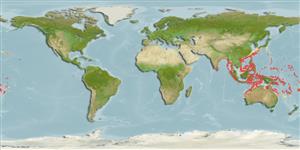Common names from other countries
>
Eupercaria/misc (Various families in series Eupercaria) >
Lutjanidae (Snappers) > Etelinae
Etymology: Etelis: Greek, etelis, -idos = a fish, perhaps the fish Sparus aurata (Ref. 45335).
Environment: milieu / climate zone / depth range / distribution range
Ecologia
marinhas demersal; intervalo de profundidade 90 - 360 m (Ref. 9821). Tropical; 35°N - 27°S, 77°E - 166°W (Ref. 55)
Indo-Pacific: Sri Lanka to Samoa, north to the Ryukyu Islands, south to Australia.
Tamanho / Peso / Idade
Maturity: Lm ? range ? - ? cm
Max length : 80.0 cm SL macho/indeterminado; (Ref. 9821); common length : 50.0 cm SL macho/indeterminado; (Ref. 9821)
Espinhos dorsais (total): 10; Raios dorsais moles (total): 11; Espinhos anais 3; Raios anais moles: 8. This species is distinguished by the following characters: body relatively elongate and laterally compressed; nostrils on each side of snout close together; lower jaw protruding and premaxillae protrusible, maxilla extending to vertical near posterior margin of orbit; small conical teeth in jaws, a few anterior ones in each jaw enlarged, sometimes into canine-like teeth; with teeth on palatine and vomer, vomerine tooth patch rounded arch-shaped or chevron-shaped; maxilla with scales, without the longitudinal ridges; interorbital region flattened; gill rakers of first
gill arch 11-15 + 20-22 = 32-36 (including rudiments); continuous dorsal fin, with spinous portion deeply incised at its junction with soft portion; last soft ray of both dorsal and anal fins produced, longer than next to last ray; caudal fin lunate, with a notch at the middle of the distal margin of the fin; pectoral fins fairly long, a little shorter than head. pectoral-fin rays 16; membranes of dorsal and anal fins without scales; tubed lateral-line scales 50-51. Colour of body mainly red, lighter on lower sides and belly (Ref. 9821).
Adults inhabit rocky bottoms. Feed mainly on fishes. Marketed fresh.
Life cycle and mating behavior
Maturidade | Reprodução | Desova | Ovos | Fecundidade | Larvas
Allen, G.R., 1985. FAO Species Catalogue. Vol. 6. Snappers of the world. An annotated and illustrated catalogue of lutjanid species known to date. FAO Fish. Synop. 125(6):208 p. Rome: FAO. (Ref. 55)
Categoria na Lista Vermelha da IUCN (Ref. 130435)
CITES (Ref. 128078)
Not Evaluated
Ameaça para o homem
Harmless
Utilização humana
Pescarias: pouco comercial; peixe desportivo: sim
Mais informação
Nomes comunsSinónimosMetabolismoPredadoresEcotoxicologiaReproduçãoMaturidadeDesovaFecundidadeOvosDesenvolvimento dos ovos
ReferênciasAquaculturaPerfil para aquaculturaEstirpesGenéticaElectrophoresesHereditariedadeDoençasProcessamentoMass conversion
Ferramentas
Relatórios especiais
Descarregue XML
Fontes da internet
Estimates based on models
Preferred temperature (Ref.
115969): 13.8 - 23.2, mean 19.1 (based on 215 cells).
Phylogenetic diversity index (Ref.
82804): PD
50 = 0.5625 [Uniqueness, from 0.5 = low to 2.0 = high].
Bayesian length-weight: a=0.02042 (0.01136 - 0.03671), b=2.95 (2.80 - 3.10), in cm Total Length, based on LWR estimates for this species & (Sub)family-body (Ref.
93245).
Nível Trófico (Ref.
69278): 4.5 ±0.80 se; based on food items.
Resiliência (Ref.
120179): Médio, tempo mínimo de duplicação da população 1,4 - 4,4 anos (Preliminary K or Fecundity.).
Fishing Vulnerability (Ref.
59153): Moderate to high vulnerability (46 of 100).
